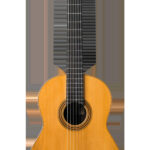The E minor 7th chord (Em7) is a staple in guitar playing, renowned for its rich, melancholic yet beautiful sound. Composed of the notes E, G, B, and D, it adds a layer of complexity and depth compared to a simple E minor chord. This unique sonic character stems from the combination of the minor tonality (G being the flat 3rd of E major) and the added 7th interval (D). For guitarists of all levels, understanding and mastering the Em7 guitar chord is a valuable step in expanding your musical vocabulary.
Fortunately, the Em7 chord is quite accessible, even for beginners. There are several open position variations that are easy to learn without sacrificing the full, resonant sound of the chord. Let’s explore three common and effective ways to play the Em7 guitar chord, complete with finger diagrams and examples of popular songs that showcase each voicing.
The Simplest Em7: One-Finger Wonder
This first variation is arguably the easiest way to play an Em7 guitar chord in open position. If you’re already comfortable with the basic E minor chord, this will be a breeze. You only need to fret one note to transform Em into Em7! This voicing is perfect for beginners as it only requires one finger and utilizes all six strings, providing a full, foundational sound.
- Middle finger: 2nd fret of the A (5th) string
Image alt text: Easy Em7 guitar chord diagram, one finger Em7 chord, middle finger on 2nd fret A string.
Strumming all six strings from the low E string downwards will produce the notes E, B, D, G, B, and E, creating a rich and complete Em7 chord.
This straightforward yet sonorous version of the Em7 chord is famously used in Marvin Gaye’s timeless hit, “Let’s Get It On”. The song’s chord progression is intentionally repetitive and simple, creating a captivating groove that allows other elements like Gaye’s soulful vocals, the iconic wah-wah guitar, and the lush horns to shine. Learning this Em7 chord shape is a quick path to playing classic songs and understanding how a simple chord can be incredibly effective in music.
A Higher-Voiced Em7: Delicate and Melodic
For a brighter, more delicate sound, this second Em7 guitar chord variation offers a higher voicing. In this version, you’ll omit the lower E and A strings, focusing on the higher register of the chord. This voicing is particularly useful for melodic passages and songs that call for a lighter touch.
To achieve this Em7 shape, position your pinky and ring fingers on the 3rd fret of the high E and B strings respectively. Then, stretch your middle finger to the 2nd fret of the D (4th) string.
- Middle finger: 2nd fret of the D (4th) string
- Ring finger: 3rd fret of the B (2nd) string
- Pinky finger: 3rd fret of the high E (1st) string
Image alt text: Higher voicing Em7 guitar chord diagram, three finger Em7 chord, fingers on D, B, and high E strings.
Strumming down from the D string across the top four strings will produce this higher-pitched Em7 chord.
This particular voicing is beautifully demonstrated in the bridge of “Say Yes” by Elliott Smith. Featured on his album Either/Or, “Say Yes” perfectly captures the magic of this Em7 variation. The bridge section, with lyrics like “Crooked spin can’t come to rest. I’m damaged bad, at best,” showcases Smith’s intricate guitar work. The guitar transitions smoothly through several complex chords, made easier by smart chord choices like this Em7. The finger positioning in this Em7 allows for quick chord changes, as the pinky and ring fingers remain anchored while the middle finger and potentially the index finger handle bass note movements. The bridge culminates in the song’s poignant thesis: “They want you or they don’t. Say yes.” This song alone is a compelling reason to learn this version of the Em7 chord.
The Full-Bodied Em7: A Rich 6-String Shape
Our final Em7 guitar chord variation combines elements of the previous two, resulting in a full, rich 6-string voicing. This formation requires a bit more finger stretching but delivers the most complex and sonically complete Em7 sound among the open position options. This is the go-to Em7 for many guitarists seeking a powerful and resonant sound.
To play this version, place your fingers as follows:
- Index finger: 2nd fret of the A (5th) string
- Middle finger: 2nd fret of the D (4th) string
- Ring finger: 3rd fret of the B (2nd) string
- Pinky finger: 3rd fret of the high E (1st) string
Image alt text: Full 6-string Em7 guitar chord diagram, four finger Em7 chord, fingers on A, D, B, and high E strings.
Strumming all six strings will unleash the full potential of this Em7 chord voicing.
As you gain experience playing guitar, you’ll begin to appreciate the subtle nuances between different chord voicings. Listening to this full-bodied Em7, it becomes clear why Oasis chose it for their anthemic song “Live Forever” (it enters at the chorus on the line “Maybe I just wanna fly”). The richness of this Em7 complements the expanded chords and grand musical style that Oasis is known for. Recognizing these patterns in music, where artists choose specific chord voicings to achieve their signature sound, is a key part of musical development.
To further your chord knowledge, explore Fender Play’s extensive chord library, learn about different chord types, and discover valuable tips for mastering guitar chords.
Ready to craft your own signature sound? Begin your free trial of Fender Play today and unlock a world of guitar chords and songs that inspire you!

